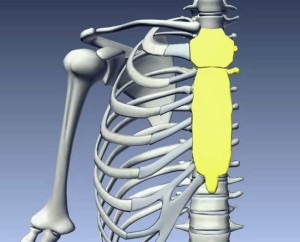Also known as the ‘Angle of Louis,’ the term sternal angle is used to define the angle which occurs at the junction of the sternum body and the manubrium.
Sternal angle – Structure
Also called the breastbone, the sternum refers to the flat and elongated T-shaped bone situated in the upper middle segment of the thoracic area. This bone consists of three parts, i.e., the sternum body, the manubrium, and the xiphoid process.
- Also referred to as the gladiolus, the sternum body constitutes the mid-section of the bony sternum. It directly joins or connects to the 7th and 3rd
- Popularly referred to as the handle, the manubrium is located at the upper segment of the sternum. It is joined to the first 2 ribs.
- The angle which forms at the connection point of the sternum body and the manubrium is known as the sternal angle. It is also called by other names like manubriosternal joint and ‘Angle of Louis.’
- The cartilaginous end situated at the lower end of the flat sternum bone is known as the xiphoid process. The sternum attaches to the ribs via the costal cartilage. It is an essential component of the thoracic area and carries out the important function of protecting the glands and organs present in the thoracic cavity.
Sternal angle – Clinical significance
- The sternal angle is situated at the meeting point of the gladiolus and the manubrium. It is palpated as a transverse prominence about five cm under the suprasternal notch. The manubriosternal joint anteriorly occurs at the level of the second costal cartilage and posteriorly between T5-4 vertebrae.
- The sternal angle acts as a landmark site wherein bifurcation of the trachea into the left and right principle bronchi occurs. It also acts as a marker for the plane of separation of inferior and superior mediastinum.
- The location of the cardiac plexus as well as the crossing of the thoracic duct from the right to the left side occurs at the level of this joint.
- The sternal angle also acts as a marker of the aortic arch’s beginning point, ending of the ascending aorta, and commencement of the descending aorta.
- The pulmonary trunk branches into two pulmonary arteries below the level of the sternal angle.
- The manubriosternal joint acts as a reference spot when counting the ribs. The 2nd pair of ribs can be located by palpating the sternal angle. The joint also corresponds to the T5/T4 intervertebral disc.
- The upper limit of the cardiac base is marked by the sternal angle.
- The joint is considered as a clinical landmark because it acts as a reference point to verify the 2nd pair of costal cartilages location. The bulge present at the front thoracic wall also contributes in helping mark certain structures occurring in the thoracic area.
The other name of the sternum angle, i.e., ‘Angle of Louis’ is named after Pierre Charles Alexandre Louis, a French physician.
Causes of pain in and around the sternal angle
- Pain around the sternal angle may occur due to certain underlying medical conditions. However, the most common cause is trauma to the sternum.
- People who play football, boxing, or other such contact sports are at greater risk to suffering from sternum injuries or fractures. Individuals with joint disorders are also vulnerable to injuries of the sternum, as weak bones can trigger health problems even with minor sternum trauma.
- Extreme strain on rib cage, thereby consequently on the manubriosternal joint, may also occur due to weightlifting.
- An intense blow to the chest, fall from a high place, and/or slamming of steering wheel against the chest during motor vehicle accidents can also result in sternum fractures, thereby causing extreme pain in ribs and the sternal angle.
- The ribs and the areas around it can also suffer from bruises due to punches to the sternum, thereby causing manubriosternal joint pain.
- Rib cage trauma can also trigger inflammation of the costosternal joint, which in turn can set the conditions for the occurrence of a health complication called costochondritis. Injuries and overuse can also result in such inflammation.
- Certain medical disorders such as Tietze’s syndrome, costochondritis, and costal cartilage calcification can cause the sternal angle to pop.
Treatment of pain in and around the sternal angle
- Individuals who experience any kind of pain in and around the sternal angle, painful breathing, and/or rib pain need to immediately consult a doctor.
- The physician will recommend a variety of diagnostic tests, including imaging procedures like x-rays, etc., to ascertain the cause of pain around the manubriosternal joint. It is possible that varied conditions and abnormalities of the organs located within the thoracic cavity is the cause of the pain. Once the doctor diagnoses the exact cause of the sternal angle pain, then it is treated as per standard medical therapies and procedures.


I was looking through some of your content on this internet site and I believe this site is really instructive! Keep putting up.
Marijuana Seeds
google.com
It’s an awesome paragraph in favor of all the internet viewers; they will take
benefit from it I am sure.
Pictures Of Gelato Seeds Strain
I got this site from my pal who informed me about this web site and now this time
I am visiting this website and reading very informative articles or reviews here.
body cellulite
I as well as my pals have been checking the best items from your web site and instantly got a horrible feeling I never expressed respect to the web blog owner for them. All of the boys are actually absolutely happy to study all of them and have in effect unquestionably been having fun with those things. Appreciate your turning out to be so considerate and also for opting for this sort of superb subject matter millions of individuals are really wanting to understand about. My very own sincere apologies for not saying thanks to earlier.